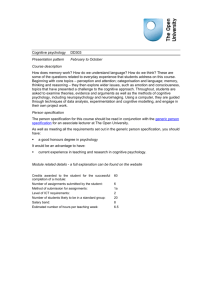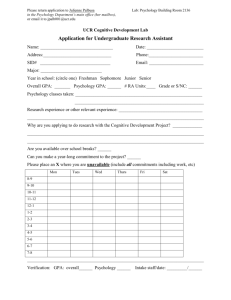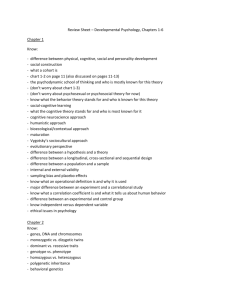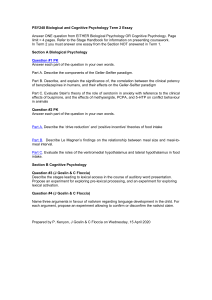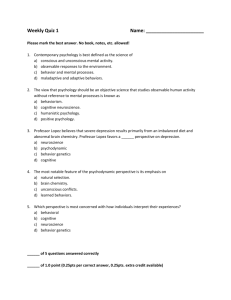Chapter 1: Cognitive Psychology: An Introduction
advertisement
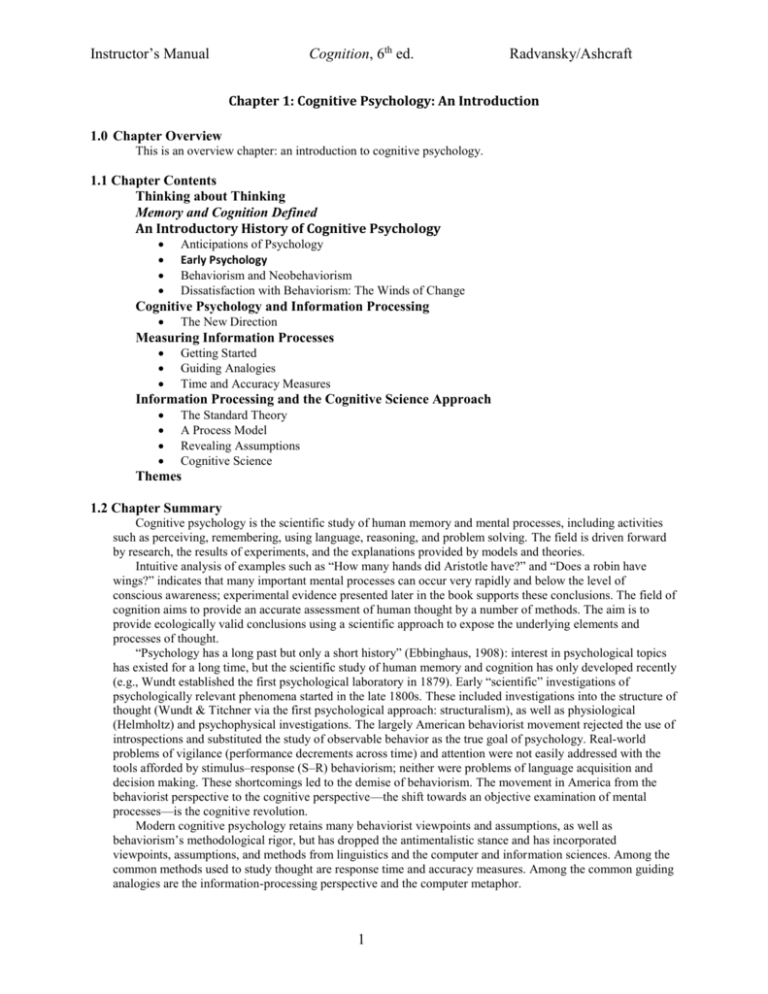
Instructor’s Manual Cognition, 6th ed. Radvansky/Ashcraft Chapter 1: Cognitive Psychology: An Introduction 1.0 Chapter Overview This is an overview chapter: an introduction to cognitive psychology. 1.1 Chapter Contents Thinking about Thinking Memory and Cognition Defined An Introductory History of Cognitive Psychology Anticipations of Psychology Early Psychology Behaviorism and Neobehaviorism Dissatisfaction with Behaviorism: The Winds of Change Cognitive Psychology and Information Processing The New Direction Measuring Information Processes Getting Started Guiding Analogies Time and Accuracy Measures Information Processing and the Cognitive Science Approach The Standard Theory A Process Model Revealing Assumptions Cognitive Science Themes 1.2 Chapter Summary Cognitive psychology is the scientific study of human memory and mental processes, including activities such as perceiving, remembering, using language, reasoning, and problem solving. The field is driven forward by research, the results of experiments, and the explanations provided by models and theories. Intuitive analysis of examples such as “How many hands did Aristotle have?” and “Does a robin have wings?” indicates that many important mental processes can occur very rapidly and below the level of conscious awareness; experimental evidence presented later in the book supports these conclusions. The field of cognition aims to provide an accurate assessment of human thought by a number of methods. The aim is to provide ecologically valid conclusions using a scientific approach to expose the underlying elements and processes of thought. “Psychology has a long past but only a short history” (Ebbinghaus, 1908): interest in psychological topics has existed for a long time, but the scientific study of human memory and cognition has only developed recently (e.g., Wundt established the first psychological laboratory in 1879). Early “scientific” investigations of psychologically relevant phenomena started in the late 1800s. These included investigations into the structure of thought (Wundt & Titchner via the first psychological approach: structuralism), as well as physiological (Helmholtz) and psychophysical investigations. The largely American behaviorist movement rejected the use of introspections and substituted the study of observable behavior as the true goal of psychology. Real-world problems of vigilance (performance decrements across time) and attention were not easily addressed with the tools afforded by stimulus–response (S–R) behaviorism; neither were problems of language acquisition and decision making. These shortcomings led to the demise of behaviorism. The movement in America from the behaviorist perspective to the cognitive perspective—the shift towards an objective examination of mental processes—is the cognitive revolution. Modern cognitive psychology retains many behaviorist viewpoints and assumptions, as well as behaviorism’s methodological rigor, but has dropped the antimentalistic stance and has incorporated viewpoints, assumptions, and methods from linguistics and the computer and information sciences. Among the common methods used to study thought are response time and accuracy measures. Among the common guiding analogies are the information-processing perspective and the computer metaphor. 1 Instructor’s Manual Cognition, 6th ed. Radvansky/Ashcraft The standard model of memory is introduced as a guiding theory of cognitive psychology. A process model is provided to give student a feel for how cognitive psychology conducts its business. Also provided are a number of assumptions cognitive psychologists may make when doing their research. The chapter concludes with a discussion of cognitive science to provide a broader perspective in which cognitive psychology fits. Cognitive science is viewed as the interdisciplinary approach used in the scientific study of thought, language, and the brain—the study of the mind. Seven themes for the entire book are also introduced in this chapter. 1.3 Key Terms Accuracy: how correct a person is in the responses given; often quantified in terms of both number correct and number incorrect. Separately, or paired with response time, it can give an indication of cognitive functioning. (p. 21) Attention: (one of the seven themes of cognition) this is an all-important but poorly understood mental process. It is limited in quantity, essential to most processing, but only partially under our control. Is it a mechanism? Is it a limited pool of mental resources? (p. 30) Behaviorism: the movement or school of psychology in which the organism’s behavior was the primary topic of interest, and the learning of new stimulus–response associations, whether by classical conditioning or by reinforcement principles, was deemed the most important kind of behavior to study. Experience is the primary factor in determining even the largest aspects of one’s behavior. Antimentalistic; associated with John B. Watson. ( p. 12) Channel Capacity: term borrowed from communications engineering: any channel—any physical device that transmits messages or information—has a limited capacity. (p. 18) Cognition: the collection of mental processes and activities used in perceiving, remembering, thinking, and understanding, as well as the act of using those processes. (p. 6) Cognitive Psychology: is an objective, empirical discipline that favors an experimental approach. The major assumptions are: 1) Mental processes exist (vs. behaviorist perspective); 2) Mental processes can be studied scientifically (vs. subjectivity of introspective method); 3) People are active information processors (vs. passive recipients of knowledge and experience). (p. 5) Cognitive Revolution: the movement away from behaviorism to re-embrace the study of memory and mental activity: instinctive drift, language, perception, judgment, and decision making. (p. 2) Cognitive Science: is the interdisciplinary (linguistics, computer science, neuroscience, and psychology) study of thought, language, and the brain; the text also defines cognitive science as “the scientific study of thought, language, and the brain—in short, the scientific study of the mind.” (p. 2) Computer Analogy: human information processing may be similar to the sequence of steps and operations in a computer program—similar to the flow of information from input to output when a computer processes information. (p. 19) Conceptually Driven Processing (top-down): when existing context or knowledge has an influence on earlier or simpler forms of mental processing. (p. 27) Context Effects: related concepts or processing can speed later processing; aA problem for process models, because there was not an easy way to accommodate context effects. (p. 27) Control Processes: the cognitive steps involved in manipulating information, such as rehearsal, in short-term memory. (p23) Data-driven (bottom-up) Processing: some processing relies heavily on the information we get from the environment. (p. 30) Ecological Validity: the extent to which experimental results provide insight into how people actually think and act in real-world situations rather than in sterile, very controlled, laboratory conditions. (p. 7) Embodiment: (one of the seven themes of cognition) the way we think about and process information reflects the fact that we need to interact with the world using our bodies. (p. 30) Empiricism: the philosophy that phenomena are to be investigated by careful objective observation. (p. 9) Explicit: direct and explicit awareness of certain types of memories (you remember the experience of buying this textbook, for example). (p. 30) Functionalism: the study of the functions of consciousness (rather than its structure); answered the questions: “What is it for?” “How does it adapt?” (p. 11) Implicit: some memories and memory processes are there, but not necessarily with conscious awareness, which raises the issue of whether (and how much) unconscious influences can affect your behavior. (p. 30) 2 Instructor’s Manual Cognition, 6th ed. Radvansky/Ashcraft Independent and Nonoverlapping Stages: in a strict information-processing approach, the idea that stage processing only starts after the prior stage has finished; processing within a stage occurs independently of processing occurring at other stages. (p. 26) Introspection: Titchner’s method, in which observers are carefully trained to report on inner sensations and experiences. (Note: this is not the self-analysis of self-help books.) It was intended to be a careful, reliable, and scientific method. Reports in which memories, rather than experiences, were reported were excluded: suffered an inherent problem of subjective bias. (p. 9) Lexical Decision Task: a timed task in which people decide whether or not letter strings are words in a participant’s language. (p. 24) Long-Term Memory (LTM): virtually permanent memory store; responsible for holding information for more than a few seconds. (p. 23) Memory: the mental processes of acquiring and retaining information for later retrieval and the mental storage system that enables these processes. (p. 6) Metacognition: our awareness of our own cognitive systems and knowledge and insight into their workings. (p. 30) Parallel Processing: multiple mental processes can operate simultaneously. (p. 26) Process Model: hypothesis about the specific mental processes that take place when a particular task is performed; a small-scale model that delineated the specific mental steps involved in a task and made testable predictions about the results. (p. 24) Reductionism: attempting to understand a complex event by breaking it down into its components. (p. 7) Response Time (RT): the time it takes to make a particular response to a stimulus; the time between stimulus onset and the time of the response. Key assumption: longer RTs are produced whenever more “mental work” is required. (p. 20) Sensory Memory: (standard theory) when environmental stimuli impinge onto the processing system, each sense modality has its own sensory register or memory. Some of this information is transferred to shortterm memory. (p. 23) Sequential Stages of Processing: an assumption of most stage models in which stages occur in a fixed sequence with no overlap between stages. (p. 25) Short-Term Memory (STM): classic term for the information store that briefly holds information in memory (for up to 20 seconds); the memory component where current and recently attended information is held; sometimes loosely associated with attention and consciousness. (p. 23) Standard Theory: sensory registers STM LTM. (Atkinson & Shiffrin) (p. 23) Structuralism: the study of the structure of the conscious mind through the study of sensations, images, and feelings (which were thought to be the very elements of the mind’s structure); structuralism failed because it was too narrow, but did provide excellent (subjective) descriptions of sensory, imaginal, and affective states of consciousness. (Titchner) (p. 10) Tabula Rasa: the experience of the individual is of paramount importance because the mind is a “blank slate” at birth that one’s life experiences write on. (p. 9) Top-Down: conceptually driven processing; it is the opposite of bottom-up (data-driven) processing. (p. 27) Verbal Learning: branch of experimental psychology that dealt with humans as they learn verbal materials, such as items or stimuli composed of letters and/or words; essentially, this was a way to study memory within the context of behaviorism. (p. 14) Verbal Protocol: have participants verbalize their thoughts (aloud, in “real time”) as they solve the problems that they are working on. (p. 28) Word Frequency Effect: faster lexical decisions to high-frequency (more common) words. (p. 25) 1.4 Key People Chomsky, Noam: linguist who wrote a review of Skinner’s Verbal Behavior that illustrated the shortcomings of a behaviorist account of language. (p. 15) Ebbinghaus, Hermann: first researcher to study memory using objective methodology (method of savings). (p. 10) James, William: major American philosopher and psychologist. He was interested in a wide array of psychological phenomena. Advocate of Functionalism. (p. 11) Titchner, Edward: English student of Wundt who came to Cornell in 1892. Titchner believed Wundt’s introspective method was the only method of obtaining psychological knowledge. Titchner’s structuralism explicitly rejected the topics of educational applications, social psychology, and mental illness. (p. 10) 3 Instructor’s Manual Cognition, 6th ed. Radvansky/Ashcraft Skinner, B.F.: behaviorist; wrote a behaviorist account of language, Verbal Behavior, that was resoundingly critiqued by Chomsky. (p. 12) Watson, John B.: viewed experience as the primary factor in determining even the largest aspects of one’s behavior. Advocate of behaviorism (1910: behaviorist manifesto). (p. 12) Wundt, Wilhelm (pronounced “voont”): 1832-1920; established the first psychological laboratory (1879), which was devoted to volkerpsychologie (folk psychology; psychology for the people)—largely focused on sensation, perception, and attention (“conscious processes and immediate experience”). (p. 9) 1.5.1 Lecture Suggestions (Effectiveness/Student Reactions) Discuss the interpretation of response times (you can leverage an example off of a discussion of Stroop effects). In doing so, be aware that some students will not realize that “faster” is associated with less cognitive work (this is an inherent assumption of most response time studies). Additionally, many students may have difficulty reading simple RT graphs (faster is on the BOTTOM of the y-axis). The first difficulty many people have with cognitive psychology is an inability to understand why anyone would be interested in it. Here are two suggestions to rectify this particular perspective: 1. After going over the syllabus for the first time, have people call out the different “types” of psychology. Afterwards, briefly describe (or ask for suggestions on) how each area or “type” of psychology could benefit or be relevant to cognitive psychology. Be sure to include clinical (types of deficits), learning (studying for exams: massed vs. distributed practice), and human factors (driving a car and talking on the cell phone = dual-task attentional demands). 2. When developing your syllabus, be sure to include an assignment within each component of the course. The purpose of the assignment is to tie the theoretical knowledge that the students are exposed to from your lecture and the textbook to “real life.” This has the advantage of providing a much more resilient memory trace (you can discuss this logic on Day 1—foreshadowing important topics such as depth of processing). If possible, use student names when responding to questions. For larger classes, make it a requirement that a student needs to answer at least one question from you during class over the course of the semester. It is easier to go from a “hard” stance regarding make-up exams or late assignments to a softer one than it is to be too soft in the beginning and then tighten your policies. 1.5.2 Lecture Suggestions (Content) Additional content: The first mention of “psychologie” as a field of research was in the context that there could not be a scientific study of psychologie (science of the mind). Part of what motivated Wundt to study the laws that regulate the mind was the success of scientific approach in other fields and the regularity of visual illusions (e.g., the horizontal–vertical illusion and the Oppel-Kundt illusion), which suggested to him that laws could govern psychological experience. Cognition: cognito = “to know” co = “together” gnoscere = “know” 1.6 Research Project Ideas Use PsycInfo to look up one of the authors of one of the major works cited in this chapter (e.g., Stroop, 1935). Judging by the titles of the articles, identify the topic area in which the researcher was interested. On the basis of your reading in Chapter 1, identify two areas of your own life where a further understanding of cognitive psychology could help you (e.g., “although you are not allowed to use this one, a great example would be ‘to help you identify good study habits’”). What are some of the relevant psychological issues that an auto manufacturer might have to consider when designing the interior of a car? Characterize the differing contributions to cognitive psychology of James, Watson, and Ebbinghaus. Identify the four “best” things that an understanding of the fundamentals of cognitive psychology can offer an undergraduate (other than a good grade in this course). Summarize your argument for your choices in a two-page, double-spaced paper. 4



